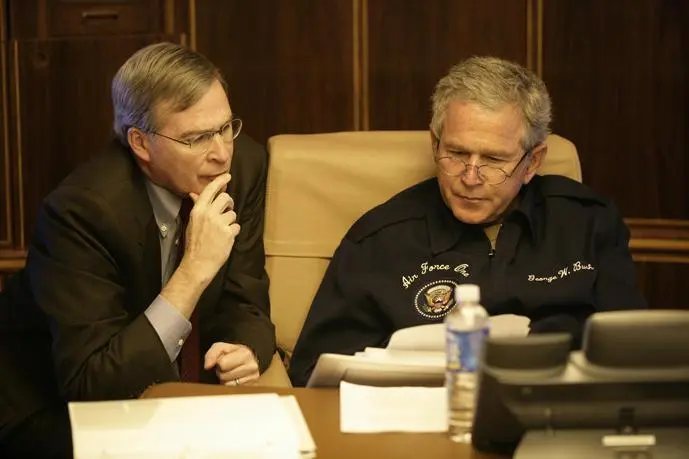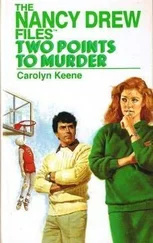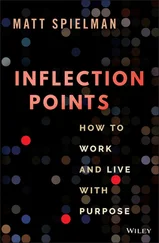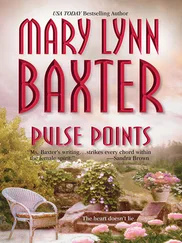Steve is a formal person. He would board the airplane for long overseas flights in his tie, sleep in his tie, and emerge with a crisp knot still in place. He once volunteered for cedar chopping at the ranch. His job was to pile up cut branches. He performed the task meticulously, effectively, and in his brogan shoes. Behind the formality, Steve is a kind, selfless, humorous man. I spent many weekends at Camp David with him and his wife, Ann. The two have a great love affair. Both are cerebral. Both are hikers. And both are great parents to their two lovely girls.

With Steve Hadley. White House/Eric Draper
I met with Steve almost every morning of my second term. After a particularly rough day in the spring of 2006, we reviewed the blue sheet at the Resolute desk. I shook my head and glanced up. Steve was shaking his head, too.
“This is not working,” I said. “We need to take another look at the whole strategy. I need to see some new options.”
“Mr. President,” he responded, “I’m afraid you’re right.”
Steve went to work organizing a detailed review. Every night, the Iraq team on the NSC staff produced a memo detailing the military and political developments of the past twenty-four hours. The picture they painted was not pretty. One day in the late spring, I asked Meghan O’Sullivan, a Ph.D. who had spent a year working for Jerry Bremer in Iraq, to stay behind after a meeting. She maintained contacts with many senior officials in the Iraqi government. I asked what she was hearing from Baghdad. “It’s hell, Mr. President,” she said.
In mid-June, Steve arranged to have a group of outside experts brief me at Camp David. Fred Kagan, a military scholar at the American Enterprise Institute, questioned whether we had enough troops to control the violence. Robert Kaplan, a distinguished journalist, recommended adopting a more aggressive counterinsurgency strategy. Michael Vickers, a former CIA operative who helped arm the Afghan Mujahideen in the 1980s, suggested a greater role for Special Operations. Eliot Cohen, the author of Supreme Command , a book about the relationship between presidents and their generals that I had read at Steve’s suggestion, told me I needed to hold my commanders accountable for results.
To provide another perspective, Steve brought me articles from colonels and one-star generals who had commanded troops in Iraq. A dichotomy emerged: While Generals Casey and Abizaid supported the train-and-withdraw strategy, many of those closest to the fight thought we needed more troops.
One who intrigued me was Colonel H.R. McMaster. I had read his book on Vietnam, Dereliction of Duty , which charged the military leadership with not doing enough to correct the strategy adopted by President Johnson and Defense Secretary Bob McNamara. In 2005, Colonel McMaster commanded a regiment in the northern Iraqi city of Tal Afar. He had applied a counterinsurgency strategy, using his troops to clear out insurgents, hold the newly taken territory, and help build the local economy and political institutions. This doctrine of clear, hold, and build had turned Tal Afar from an insurgent stronghold to a relatively peaceful, functioning city.
Another practitioner of counterinsurgency was General David Petraeus. I first met him at Fort Campbell in 2004. He had a reputation as one of the smartest and most dynamic young generals in the Army. He had graduated near the top of his class at West Point and earned a Ph.D. from Princeton. In 1991, he was accidentally shot in the chest during a training exercise. He endured a sixty-mile helicopter flight to Vanderbilt University Medical Center, where his life was saved by Dr. Bill Frist, later the Republican leader of the Senate.
Early in the war, General Petraeus had commanded the 101st Airborne Division in Mosul. He sent his troops to live alongside Iraqi residents and patrol the streets on foot. Their presence reassured residents that we were there to protect them. Petraeus then held local elections to form a provincial council, spent reconstruction funds to revive economic activity, and reopened the border with Syria to facilitate trade. His approach was textbook counterinsurgency. To defeat the enemy, he was trying to win over the people.
It worked. While violence in much of Iraq increased, Mosul remained relatively calm. But when we reduced troops in Mosul, violence returned. The same would happen in Tal Afar.
After overseeing training of the Iraqi security forces, General Petraeus was assigned to Fort Leavenworth, Kansas, to rewrite the Army’s counterinsurgency manual. The premise of counterinsurgency is that basic security is required before political gains can follow. That was the reverse of our existing strategy. I decided to keep a close eye on General Petraeus’s work—and on him.

Amid all the bad news of 2006, we did have one bright spot. In early June, Special Forces under the command of the highly effective General Stanley McChrystal tracked down and killed Zarqawi, al Qaeda’s leader in Iraq. For the first time since the December elections, we were able to show the public a dramatic sign of progress.
A week later, I quietly slipped out of Camp David after a day of NSC meetings. I hopped on an Army transport helicopter with a small group of aides, flew to Andrews Air Force Base, and boarded Air Force One. Eleven hours later, we landed in Baghdad.
Unlike my Thanksgiving trip in 2003, when my meetings took place at the airport, I decided to meet Maliki in the Green Zone, the fortified complex in central Baghdad. Army helicopters flew us over the city fast and low, shooting off an occasional flare as a protection against a heat-seeking missile. The prime minister was waiting for me when I got to the embassy. Ever since his selection in April, I had wanted to see Maliki face to face. In our phone calls, he had said the right things. But I wondered if his assurances were real.
“Your decisions and actions will determine success,” I told him. “It will not be easy, but no matter how hard it is, we’ll help you.”
Maliki thanked America for liberating the country and affirmed his desire for a close friendship. “We will achieve victory over terror, which is a victory for democracy,” he said. “There are a lot of dark people who fear our success. They are right to be worried, because our success will unseat them from their thrones.”
The prime minister had a gentle manner and a quiet voice, but I sensed an inner toughness. Saddam Hussein had executed multiple members of Maliki’s family, yet he had refused to renounce his role in the opposition party. His personal courage was a seed that I hoped to nurture, so he could grow into the strong leader the Iraqis needed.
The prime minister took me into a conference room to meet his cabinet, which included Shia, Sunni, and Kurdish leaders. I introduced him to my team via videoconference. My advisers, who did not know that I had left Camp David, were stunned to see me in Baghdad. The Iraqis were thrilled to address their counterparts for the first-ever joint national security meeting between the United States and Iraq.
The other pivotal meeting of the trip was with George Casey. The hardworking general had been in Iraq for two years, extending his tour at my request. He told me that 80 percent of the sectarian violence occurred within thirty miles of Baghdad. Controlling the capital was vital to calming the rest of the country.
General Casey was planning a new effort to secure Baghdad. The offensive, Operation Together Forward, would attempt to apply the clear, hold, and build approach that had once succeeded in Tal Afar and Mosul.
Читать дальше













